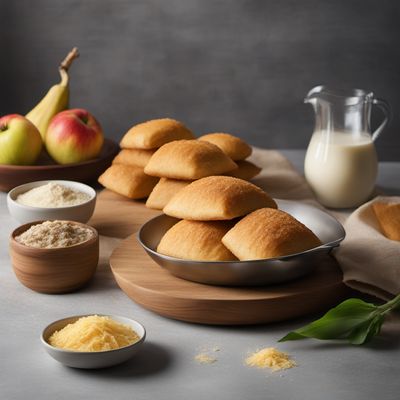
Ingredient
Cheese, cheddar
"The King of Cheeses: Unveiling the Richness of Cheddar"
Cheddar cheese is a semi-hard cheese with a smooth, firm texture and a pale yellow to orange color. It is made from cow's milk and undergoes a process of aging, which contributes to its distinct flavor and texture. Cheddar has a rich, creamy taste with a slightly sharp and tangy undertone. Its texture can vary from crumbly to smooth, depending on the age and quality of the cheese. Its appearance is characterized by a smooth, glossy surface and a dense interior.
Origins and history
Cheddar cheese originated in the English village of Cheddar in Somerset. It has a long history dating back to the 12th century when it was first produced by local farmers. Originally, cheddar was made using traditional methods, including the use of cloth-bound molds and aging in caves. Over time, cheddar cheese gained popularity and spread beyond the village, becoming one of the most widely consumed cheeses worldwide.
Nutritional information
Cheddar cheese is a good source of protein, calcium, and phosphorus. It also contains essential vitamins such as vitamin A and vitamin B12. However, it is important to note that cheddar cheese is high in saturated fat and sodium, so moderation is key.
Allergens
Cheddar cheese contains milk, making it unsuitable for individuals with lactose intolerance or milk allergies.
How to select
When selecting cheddar cheese, look for a cheese that is firm and free from any cracks or mold. Opt for cheese that has a rich, vibrant color and a pleasant aroma. It is also advisable to choose cheddar cheese that has been aged for a longer period, as it tends to have a more complex flavor.
Storage recommendations
To maintain the freshness and quality of cheddar cheese, it is best stored in the refrigerator in its original packaging or wrapped tightly in wax paper or aluminum foil. Avoid storing it in plastic wrap, as it can trap moisture and affect the cheese's texture. Cheddar cheese should be consumed within a few weeks of opening.
How to produce
While producing cheddar cheese requires specialized equipment and knowledge, amateur cheese enthusiasts can try their hand at making simple fresh cheddar cheese using readily available ingredients and basic cheese-making techniques.
Preparation tips
Cheddar cheese is incredibly versatile and can be enjoyed in various ways. It can be grated and melted over dishes like macaroni and cheese or used as a topping for burgers and sandwiches. Cheddar cheese also pairs well with fruits, crackers, and bread. For optimal flavor, bring cheddar cheese to room temperature before serving.
Substitutions
Suitable substitutes for cheddar cheese include Gouda, Colby, or Monterey Jack cheese, which offer similar melting properties and flavor profiles.
Culinary uses
Cheddar cheese is a staple in many dishes, including grilled cheese sandwiches, cheeseburgers, and macaroni and cheese. It is also commonly used in salads, soups, and casseroles to add a rich and creamy element. Cheddar cheese can be enjoyed on its own or paired with fruits, crackers, and bread.
Availability
Cheddar cheese is widely available in supermarkets and grocery stores worldwide. It is also produced in various countries, including the United States, United Kingdom, Canada, and Australia.
More ingredients from this category » Browse all

Cheese, aged graviera
Savory Greek Delight

Cheese, murcia
The Tangy Delight: Murcia Cheese

Cheese, roncal
The Quintessential Spanish Delight: Roncal Cheese

Cheese, majorero
Majorero: The Flavorful Cheese from the Canary Islands

Cheese, leyden
The Dutch Delight: Unveiling the Savory Secrets of Leyden Cheese

Cheese, coolea
Coolea Cheese: A Taste of Irish Craftsmanship

Cheese, iberico
The Quintessential Delight: Exploring the Richness of Iberico Cheese

Cheese, idiazabal
The Basque Treasure

Cheese, mahon
The Quintessential Taste of Mahon: Exploring the Richness of Mahon Cheese

Cheese, schabziger
The Alpine Secret: Unveiling the Tangy Delights of Schabziger Cheese

Cheese, montasio
The Alpine Delight: Exploring the Richness of Montasio Cheese

Cheese, kefalotyri
The Bold Greek Delight
Recipes using Cheese, cheddar » Browse all

New Mexican Style Spring Rolls
Southwestern Spring Rolls with a Spicy Twist

Ploughman's Delight
A British Classic: Ploughman's Delight - A Hearty Feast of Flavors

Vegetarian Enchiladas
Savory and Satisfying Veggie Enchiladas

Pan de Yuca with a Twist
Cheesy Yuca Bread Delight

Huevos Rancheros
Ranch-style Eggs

Bahamian Baked Macaroni & Cheese
Caribbean Comfort: Baked Macaroni & Cheese with a Bahamian Twist

Caribbean Baked Cheese
Tropical Delight: Caribbean Baked Cheese with a Twist

Fast Food Gulyás
Quick and Tasty Gulyás Burger

Fijian Tortionata
Tropical Twist: Fijian Tortionata with a Pacific Flair

Chilean Pichanga with a Twist
Sizzling Fusion: A Modern Twist on Chilean Pichanga

Lowcountry Shrimp and Grits Puffs
Savory Shrimp and Grits Puffs with a Lowcountry Twist

Rocky Mountain Cheesy Pasta
Mountain Melting Delight